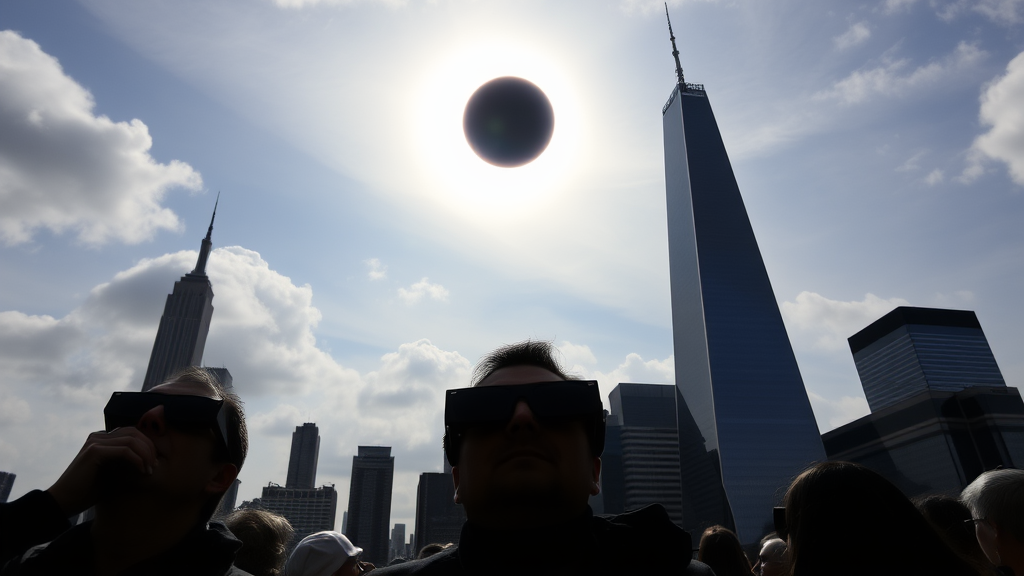Here at Associate Ophthalmologist, we have encountered a number of patients inquiring about safe solar eclipse viewing tips for the upcoming phenomenon that will take place on August 21, 2017. Many eclipse chasers will travel across the United States to areas in the Path of Totality (ie. as Oregon, Iowa, Illinois, Kentucky, and the Carolinas) to witness a rare and spectacular total solar eclipse. Sky watchers outside of this direct path will be able to experience a Partial Solar Eclipse. The total phase of this solar eclipse is not visible in New York, but it can be observed as a partial solar eclipse when it begins with the Moon touching the Sun’s edge at 1:23 pm EST. Maximum Eclipse will be observed at 2:44pm EST when the Moon is closest to the center of the Sun. The eclipse ends at 4:00 pm EST with the Moon leaving the Sun’s edge.
Watching a solar eclipse can be a thrilling experience. However, it’s essential to prioritize safety while enjoying this celestial event. Here are some safe solar eclipse viewing tips to protect your eyes. Understanding the dangers of viewing this astronomical event without proper protection can help ensure a safe and enjoyable experience.
Safe Viewing Techniques
Looking directly at the sun, even during an eclipse, can cause serious eye damage. The only way to safely view the Sun – eclipsed or not – is to either project or filter the Sun’s rays.
- Use Eclipse Glasses: Always wear proper solar eclipse glasses. Regular sunglasses are not safe. NASA recommends welder’s goggles rated 14 or higher and can be found at your local welding, plumbing supply or hardware stores. The American Astronomical Society has compiled a list of reputable vendors where you can buy safe eclipse glasses.
- Solar Viewers: Consider using solar viewers or filters designed for eclipse viewing. Solar filtering spectacles should meet ISO 12312-2 (International Organization for Standardization) compliance standards.
- Pinhole Projectors: You can create a simple pinhole projector where one card should have a small hole punched in it, while the other card remains blank to be the projection screen. This method allows you to view the eclipse indirectly. With your back against the sun, raise the pinhole card to allow the light through and project the image onto the blank card. The eclipse will be inverted but safe to look at. You can also use binoculars in place of the pinhole card with large end towards the sun.
Additional Tips
- Check for Certification: Ensure that your eclipse glasses meet the ISO 12312-2 safety standard.
- Supervise Kids: Always supervise children when viewing an eclipse to ensure they use safe techniques.
DO NOT LOOK AT THE SUN THROUGH BINOCULARS OR ANY LENSES. NEVER use regular sunglasses or cataract goggles to observe the sun as they do not provide adequate protection.

The Sun is the biggest star in our Solar System that is a giant ball of gas consisting mostly of hydrogen and produces heat and light by nuclear fusion. Just as the UV rays from the Sun can cause skin damage, it can cause sunburns to the unprotected eyes and blind you, a condition known as Solar Retinopathy in which the retina’s photoreceptors, the rods (for seeing in the dark) and cones (for color vision), become damaged. Prolonged UV exposure can damage the macula, a tiny substructure of the retina responsible for the majority of your central detail vision. Damaging it can cause macular degeneration, eventually resulting in permanent blindness in the center of your field of vision.
Besides immediate damage, one can also experience latent effects, such as photokeratitis, can also occur where the cornea, transparent surface of the eye, is sunburnt from UV light resulting in pain, excessive tearing, sandy sensation, blisters and inflammation. Long-term UV light exposure can also lead to premature advancement of cataracts and worsen dry eye condition resulting in invasive tissue growth on the surface of the eye known as pterygium. These conditions can obscure vision and lead to blindness.
By following these Safe Solar Eclipse Viewing Tips, you can enjoy the beauty of the eclipse without risking your eyesight. Remember, safety first!
For more information on viewing safety, go to http://www.eclipse2017.org/eclipse2017_eye%20safety.htm
- Categories
- News (23)
- Tips (14)
- Uncategorized (1)